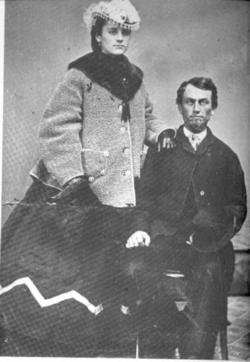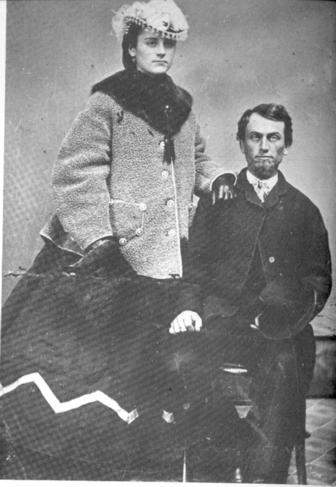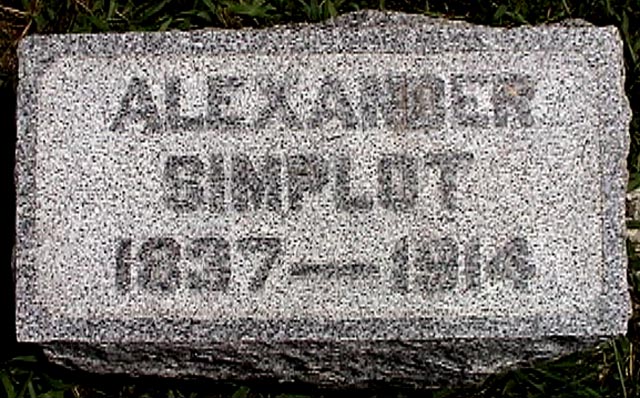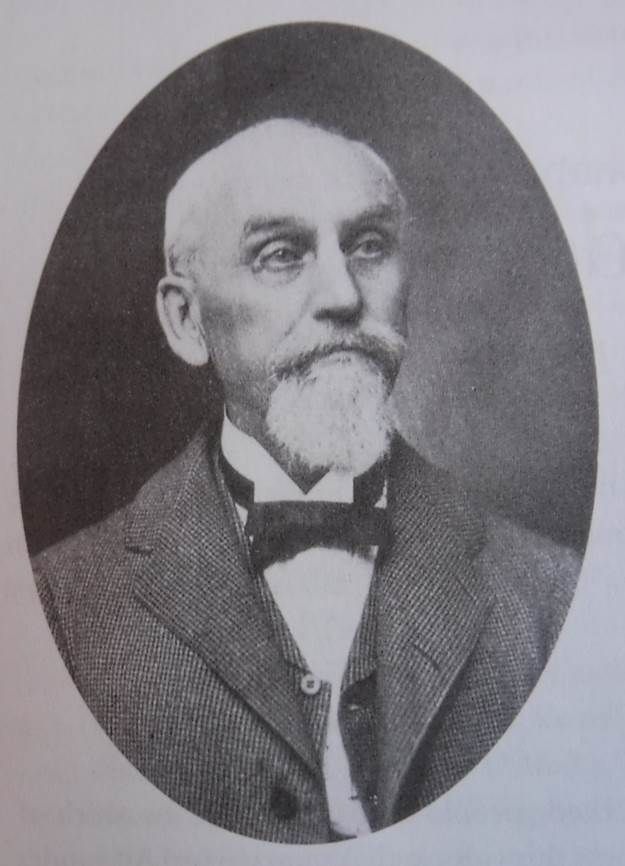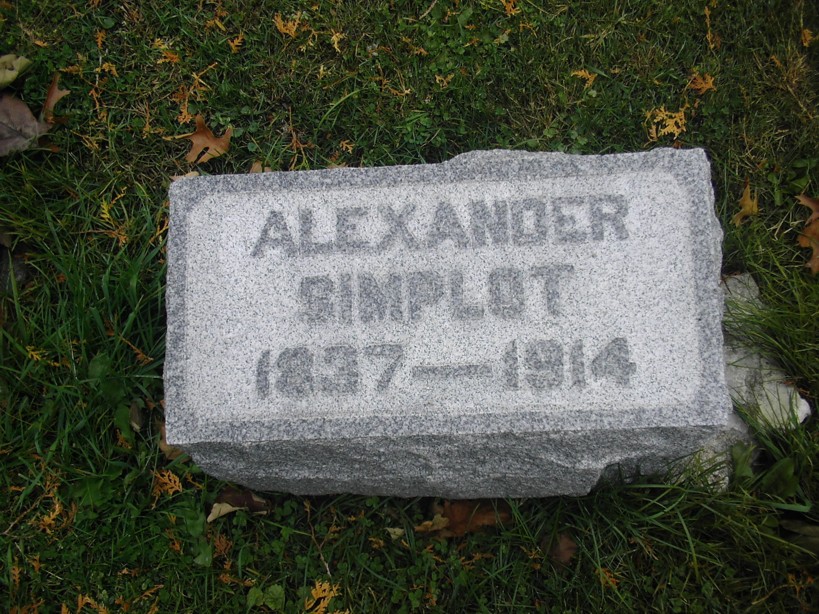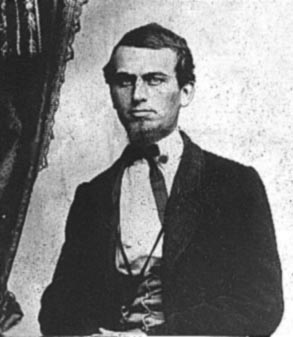"Alexander was born in a log cabin in Dubuque (on what was later to become Main Street, between 5th and 6th Streets), and was reported to be the first white child born in the State of Iowa. Alexander was unusually well-educated for the time. Young Alex went to the little school conducted by the Dubuque Cathedral Parish. He then attended Rock River Seminary (equivalent to high school) at Mt. Morris, Illinois where classmates John A. Rawlings and later Illinois Governor Cullom also attended. John Rawlings was later to become adjutant to General Grant ... which proved valuable later to Alex as a means of personally interviewing the General when other correspondents were unable to do so. Alex entered Union College at Schenectady, New York, graduating from the Law Department in the class of 1858. Although he delivered a commencement address at his graduation entitled "Plea for Artists", his parents discouraged his desire to pursue an artistic career.
After graduating from college, Alexander returned to Dubuque and taught school. When the first 200 troops (the "Governor's Greys") left from Dubuque for duty with the Union army on the steamboat Alhambra, Alexander Simplot was there with his sketch pad to record the event. He sent the picture to Harpers Weekly, whose editors liked it and hired him to go to Cairo, Illinois and serve as a Civil War artist/correspondent for the magazine. He was part of a group of correspondents that came to be known as "The Bohemian Brigade" as documented by the Dubuque Telegraph Herald dated March 8, 1964 and in the book by James M. Perry published under that title in the year 2000.
During his tenure with Harpers Weekly, which had 115,000 subscribers, Alexander documented the efforts of General Fremont, Commodore Foote, and General U.S. Grant. At any given time the number of special artists covering the war numbered no more than 12, and during the four years of the war totaled only about 30. Harpers still ranks him 13th among the 28 special artists to whom 10 or more published drawings can be credited. He headquartered at Cairo, Illinois, and covered the battles along the Mississippi. He was the only artist present to cover the Battle of Memphis. The original Alex Simplot painting of Citizens of Galena welcoming General Grant home hung in Kyle Simplot's bedroom when he was growing up ... and he currently is in possession of Alex's diary written in 1856. Alexander returned home in 1866. Shortly thereafter he married Virginia Knapp (a former student). Alexander was later known in Dubuque as an accomplished artist, an enterprising engraver, and a pioneer member of the Early Settlers Association. He designed a monument to Julien Dubuque, founder of the City, and it still stands over the Mississippi River. After the Civil War, Alexander continued to use his artistic talents as a lithographer, photo-engraver and designer of the Julien House building in Dubuque.
Maurine Tichirgi, grandaughter of Alex, comments that he was a very refined and cultured gentleman. She reports that he lost a fortune on the wheat market and as a result his large family was suddenly launched into financial tight times from which he ultimately recovered. He vowed that he would never do manual labor, and he never did. He must have been quite a philosopher and was ambitious for his children. He would quote from the Classics, Poor Richard's Almanac, the Bible, etc. He was widely and generally esteemed because of his sincerity and unassuming manner.
Alexander died at the home of his son, Alvin Simplot, at 281 College Avenue, Dubuque, Iowa, and is buried in Linwood Cemetery in Dubuque (lot 447, section 2). The funeral of Alex Simplot was held at Walton Chapel and conducted by the Rev. H. F. Milligan of First Congregational Church. The Dubuque Early Settlers Association attended in a body. Hundreds of people paid their last respects and floral tributes abounded."
Newspaper article kindly sent by Cheryl Locher Moonen: Dubuque Daily Herald, Sep. 30, 1866
OIL PAINTING – Mr. Alex Simplot has created for the Aetna Insurance Company, an oil painting, with a advertisement card containing a view of Dubuque, taken from from the bluff below Pelan's saw mill, and a representation of Mount Aetna in Italy, which the agents, Messrs. Smith & Plaister, donated to the Produce Exchange, and it now graces the walls of that institution, the work is well executed and gives a correct representation of Dubuque, more natural, we think than anything yet published in Dubuque. Mr. Simplot is an artist of much ability, and his productions are noted for their accurate delineations, either on paper or on cloth. He was a “sketcher' during the war for Harper's Weekly, and although at the present a dry goods merchant, has a taste for the art of drawing and painting.
__________________________________
From Find-A-Grave contributer HJ:
From a typed sheet of paper found tucked in an old book:
Alex Simplot was a Dubuque engraver and designer who had offices in the Julian House Building. He was born in a log cabin in Dubuque on January 5, 1837. The house was on Main Street. His parents were Henry and Susan Simplot, early settlers. His father was in the mercantile business. Alex attended the public school and Rock River Seminary. He graduated from Union College in 1858 and was a special artist for Harper’s weekly during the Civil War, and traveled with Gen. Fremont, Commander Foote and Gen. Grant. “Mr. Simplot had a large experience as an artist in sketching and engraving and has an extended reputation; he works by the new photoengraving process, and with excellent success, and has all he can do with his other business.” - Pp. 881-82 History of Dubuque County, Chicago, 1880. (The book contains an 1872 Simplot frontispiece view of Dubuque.)
"Alexander was born in a log cabin in Dubuque (on what was later to become Main Street, between 5th and 6th Streets), and was reported to be the first white child born in the State of Iowa. Alexander was unusually well-educated for the time. Young Alex went to the little school conducted by the Dubuque Cathedral Parish. He then attended Rock River Seminary (equivalent to high school) at Mt. Morris, Illinois where classmates John A. Rawlings and later Illinois Governor Cullom also attended. John Rawlings was later to become adjutant to General Grant ... which proved valuable later to Alex as a means of personally interviewing the General when other correspondents were unable to do so. Alex entered Union College at Schenectady, New York, graduating from the Law Department in the class of 1858. Although he delivered a commencement address at his graduation entitled "Plea for Artists", his parents discouraged his desire to pursue an artistic career.
After graduating from college, Alexander returned to Dubuque and taught school. When the first 200 troops (the "Governor's Greys") left from Dubuque for duty with the Union army on the steamboat Alhambra, Alexander Simplot was there with his sketch pad to record the event. He sent the picture to Harpers Weekly, whose editors liked it and hired him to go to Cairo, Illinois and serve as a Civil War artist/correspondent for the magazine. He was part of a group of correspondents that came to be known as "The Bohemian Brigade" as documented by the Dubuque Telegraph Herald dated March 8, 1964 and in the book by James M. Perry published under that title in the year 2000.
During his tenure with Harpers Weekly, which had 115,000 subscribers, Alexander documented the efforts of General Fremont, Commodore Foote, and General U.S. Grant. At any given time the number of special artists covering the war numbered no more than 12, and during the four years of the war totaled only about 30. Harpers still ranks him 13th among the 28 special artists to whom 10 or more published drawings can be credited. He headquartered at Cairo, Illinois, and covered the battles along the Mississippi. He was the only artist present to cover the Battle of Memphis. The original Alex Simplot painting of Citizens of Galena welcoming General Grant home hung in Kyle Simplot's bedroom when he was growing up ... and he currently is in possession of Alex's diary written in 1856. Alexander returned home in 1866. Shortly thereafter he married Virginia Knapp (a former student). Alexander was later known in Dubuque as an accomplished artist, an enterprising engraver, and a pioneer member of the Early Settlers Association. He designed a monument to Julien Dubuque, founder of the City, and it still stands over the Mississippi River. After the Civil War, Alexander continued to use his artistic talents as a lithographer, photo-engraver and designer of the Julien House building in Dubuque.
Maurine Tichirgi, grandaughter of Alex, comments that he was a very refined and cultured gentleman. She reports that he lost a fortune on the wheat market and as a result his large family was suddenly launched into financial tight times from which he ultimately recovered. He vowed that he would never do manual labor, and he never did. He must have been quite a philosopher and was ambitious for his children. He would quote from the Classics, Poor Richard's Almanac, the Bible, etc. He was widely and generally esteemed because of his sincerity and unassuming manner.
Alexander died at the home of his son, Alvin Simplot, at 281 College Avenue, Dubuque, Iowa, and is buried in Linwood Cemetery in Dubuque (lot 447, section 2). The funeral of Alex Simplot was held at Walton Chapel and conducted by the Rev. H. F. Milligan of First Congregational Church. The Dubuque Early Settlers Association attended in a body. Hundreds of people paid their last respects and floral tributes abounded."
Newspaper article kindly sent by Cheryl Locher Moonen: Dubuque Daily Herald, Sep. 30, 1866
OIL PAINTING – Mr. Alex Simplot has created for the Aetna Insurance Company, an oil painting, with a advertisement card containing a view of Dubuque, taken from from the bluff below Pelan's saw mill, and a representation of Mount Aetna in Italy, which the agents, Messrs. Smith & Plaister, donated to the Produce Exchange, and it now graces the walls of that institution, the work is well executed and gives a correct representation of Dubuque, more natural, we think than anything yet published in Dubuque. Mr. Simplot is an artist of much ability, and his productions are noted for their accurate delineations, either on paper or on cloth. He was a “sketcher' during the war for Harper's Weekly, and although at the present a dry goods merchant, has a taste for the art of drawing and painting.
__________________________________
From Find-A-Grave contributer HJ:
From a typed sheet of paper found tucked in an old book:
Alex Simplot was a Dubuque engraver and designer who had offices in the Julian House Building. He was born in a log cabin in Dubuque on January 5, 1837. The house was on Main Street. His parents were Henry and Susan Simplot, early settlers. His father was in the mercantile business. Alex attended the public school and Rock River Seminary. He graduated from Union College in 1858 and was a special artist for Harper’s weekly during the Civil War, and traveled with Gen. Fremont, Commander Foote and Gen. Grant. “Mr. Simplot had a large experience as an artist in sketching and engraving and has an extended reputation; he works by the new photoengraving process, and with excellent success, and has all he can do with his other business.” - Pp. 881-82 History of Dubuque County, Chicago, 1880. (The book contains an 1872 Simplot frontispiece view of Dubuque.)
Inscription
Alexander Simplot, 1837 - 1914
Family Members
Sponsored by Ancestry
Advertisement
Records on Ancestry
Advertisement
